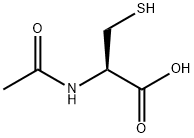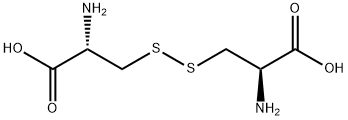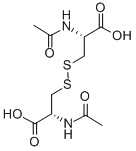A0636312
N-Acetyl-L-Cysteine , USP,EP,≥98.5% , 616-91-1
Synonym(s):
N-Acetyl-L-cysteine;NAC;ACAC;2-Acetamido-3-mercaptopropionic acid;ACACA
CAS NO.:616-91-1
Empirical Formula: C5H9NO3S
Molecular Weight: 163.19
MDL number: MFCD00004880
EINECS: 210-498-3
| Pack Size | Price | Stock | Quantity |
| 250g | RMB215.20 | In Stock |
|
| 1KG | RMB719.20 | In Stock |
|
| others | Enquire |
Update time: 2022-07-08
PRODUCT Properties
| Melting point: | 106-108 °C(lit.) |
| alpha | -35.1 ºC (c=2,H2O) |
| Boiling point: | 407.7±40.0 °C(Predicted) |
| bulk density | 730kg/m3 |
| Density | 1.249 (estimate) |
| vapor pressure | 0Pa at 20℃ |
| refractive index | 24 ° (C=JPC Method) |
| storage temp. | 2-8°C |
| solubility | H2O: 100 mg/mL with heating |
| pka | pK1: 9.52 (30°C) |
| form | Solid |
| color | White |
| PH | 1.5-2.5 (20°C, 100g/L in H2O) |
| biological source | rabbit |
| Water Solubility | Soluble in water, ethanol, methanol, dimethyl sulfoxide, hot isopropyl alcohol, methyl acetate and ethyl acetate. Insoluble in chloroform and ether. |
| Merck | 14,88 |
| BRN | 1724426 |
| Specific Activity | ≥20units/μg protein |
| Stability: | Stable. Incompatible with strong oxidizing agents. |
| InChIKey | PWKSKIMOESPYIA-BYPYZUCNSA-N |
| LogP | -0.6 at 23℃ |
| CAS DataBase Reference | 616-91-1(CAS DataBase Reference) |
| NIST Chemistry Reference | Acetylcysteine(616-91-1) |
| EPA Substance Registry System | L-Cysteine, N-acetyl- (616-91-1) |
Description and Uses
N-Acetyl-L-cysteine is an N-acetylated derivative of cysteine, which contains a sulfhydryl group in the molecule, which can break the disulfide bond (-S-S-) of the mucin peptide bond, so that the mucin chain becomes a small molecule peptide chain, reducing The viscosity of mucin, so It is a dissolving drug for mucus in mucus, purulent sputum and respiratory tract.
A metabolite of Methyl Isocyanate.
N-Acetyl-L-cysteine, by itself a poor scavenger of oxidants, is converted inside cells to yield sulfane sulfur species, which are very potent scavengers of oxidants.
Safety
| Symbol(GHS) |  GHS07 |
| Signal word | Warning |
| Hazard statements | H319 |
| Precautionary statements | P264-P280-P305+P351+P338-P337+P313 |
| Risk Statements | 36/37/38 |
| Safety Statements | 22-24/25 |
| WGK Germany | 3 |
| RTECS | HA1660000 |
| F | 10-23 |
| TSCA | Yes |
| HS Code | 29309016 |
| Hazardous Substances Data | 616-91-1(Hazardous Substances Data) |
| Toxicity | LD50 orally in rats: 5050 mg/kg (Goldenthal) |



